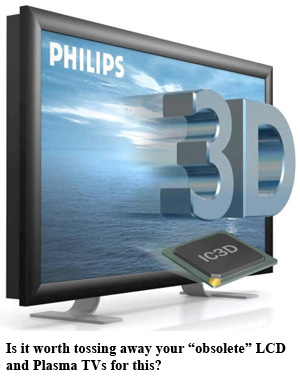This post has not been edited by the GamesBeat staff. Opinions by GamesBeat community writers do not necessarily reflect those of the staff.

Something’s wonky in the consumer-electronics market. Captains of industry are betting the house on a technology that no one seems to want, and consumers are letting out a collective, disinterested sigh. Meanwhile, the press has begun reversing opinion on the 3DS, moving from giddily ecstatic to cautiously optimistic. The miracle of autostereoscopic 3D is suddenly looking fallible. Through it all, the industry continues to promote a technology that is actually little more than an optical illusion. To me, it looks like a certain three-dimensional bubble is on the verge of bursting.
James Cameron bestowed 3D upon us, whether we wanted it or not. And judging by the 3D TV’s lackluster performance, it’s becoming increasingly obvious that we don't. But that hasn’t stopped the Oscar-winning director from surging ahead. Cameron has partnered with Avatar cameraman Vince Pace to form a venture focused on “driving the widespread adoption of 3D technology in episodic television, sports, and advertising.”
Says Cameron, “3D is just how all broadcast entertainment will be done. Sports, episodic drama, scripted and unscripted — we haven't seen anything yet that doesn't have a great degree of value added by being in 3D.”
 But the purveyors of 3D haven't yet adequately explained how it improves an experience. Stereoscopic 3D isn’t a natural phenomenon. The industry loves to point out that we don’t see the world in "2D.” But we don’t see it in “3D,” either. In reality, we see two 2D images, and our brains combine them; it's not a manner of focusing the eyes in an unnatural way. 3D is, and always has been, an optical illusion — a trick that manipulates our eyes into perceiving added depth.
But the purveyors of 3D haven't yet adequately explained how it improves an experience. Stereoscopic 3D isn’t a natural phenomenon. The industry loves to point out that we don’t see the world in "2D.” But we don’t see it in “3D,” either. In reality, we see two 2D images, and our brains combine them; it's not a manner of focusing the eyes in an unnatural way. 3D is, and always has been, an optical illusion — a trick that manipulates our eyes into perceiving added depth.
Nintendo’s 3DS provides an interesting microcosm of the 3D phenomenon. The autostereoscopic handheld (rumored to utilize display tech from Sharp) uses a parallax barrier to create an illusory 3D effect, without the need for special glasses. At its unveiling, the 3DS’ autostereoscopic capabilities floored journalists almost universally. A few of us were skeptical, but I digress.
Now that the system has launched, many of these same analysts have changed their tune. Suddenly, they’re a bit more cautious about the system’s gimmicky claim to fame. They’ve suddenly realized that the 3DS' narrow “sweet spot” is extremely problematic for a portable device — especially one that incorporates accelerometer technology. And they’ve also abruptly discovered that 12 percent of the population can’t even perceive 3D properly.
Even Nintendo backpedaled a bit. Prior to launch, 3DS producer Hideki Konno downplayed the notion that 3DS games would require the utilization of 3D. “We want to get software out to as many people as possible, and there are some people who just can’t see 3D," he said in a Wired interview. "We’re moving away from any stance that says if you don’t use the 3D functionality you can’t play this game.” Essentially, Nintendo was waving the white flag. The 3DS’ biggest selling point, it turns out, was merely an added bonus.
 The 3DS is emblematic of the industry’s heedless push for 3D, irrespective of consumers’ lukewarm reception. The technology dominated the past two Consumer Electronics Shows. Industry giants begged consumers to swap their "obsolete" LCD, LED, and plasma sets for "upgraded" 3D models. But moving from CRT to flat screen is much more dramatic than the incremental leap from LCD to 3D. Consumers aren’t biting. So the industry responded by redoubling its efforts: Consumers need to be "educated." Clearly, they just don’t see the benefits.
The 3DS is emblematic of the industry’s heedless push for 3D, irrespective of consumers’ lukewarm reception. The technology dominated the past two Consumer Electronics Shows. Industry giants begged consumers to swap their "obsolete" LCD, LED, and plasma sets for "upgraded" 3D models. But moving from CRT to flat screen is much more dramatic than the incremental leap from LCD to 3D. Consumers aren’t biting. So the industry responded by redoubling its efforts: Consumers need to be "educated." Clearly, they just don’t see the benefits.
ASilzars, an Electronic Component News reader, points out the inherent problem with 3D: It neglects the depth cues provided by head movement and depth of focus, creating an insurmountable eye-brain conflict. In turn, this gives 3D the appearance of a high-end diorama. Objects "pop" unnaturally and counterfeit a feeling of depth. Like any optical illusion, the viewer is automatically suspicious that the image is fooling his or her eyes.
If any scenario that allows for significant market penetration exists, it will be through a Trojan-horse method. In the case of the 3DS, consumers buy into Nintendo’s good name and the promise of future installments of beloved franchises. When all new TVs are automatically 3D-ready, the stealthy invasion will be complete. Ipso facto, we’ll have a 100 percent adoption rate. But don't expect this any time soon, if ever.
